Asus ZenBook Pro 14 Duo review: Is this the dual-display notebook perfected?


Asus has been working hard on the concept of dual-display notebooks for a while. This here is the ZenBook Pro 14 Duo UX8402. It is their third take at a 14-inch ultraportable-ish notebook with dual displays. And I’m not going to beat around the bush, thanks to a series of incremental tweaks and changes, they have made it better. But what did they do exactly? Let’s dive into that right now.
From the outside, it’s hard to tell what has changed. One way to tell that it’s new is the redesigned lid. There’s the new arrow-shaped ZenBook logo. The signature ZenBook concentric motif is still there, but it’s more subtle now. The notebook is made with magnesium-aluminium alloy and the overall build quality is good. The chassis feels stiff and strong, and there’s minimal flex.
Weight has gone up a tad from 1.6kg to 1.75kg, while thickness remains roughly the same at 17.9mm. Though that sounds chunky, the extra heft didn’t bother me too much. Sure, it feels denser than a typical ultraportable notebook but it’s by no means unwieldy and difficult to carry around. And lest you forget, this notebook has dual screens and discrete graphics.
Open the notebook, however, and you’ll notice the first big change to the notebook. The entire hinge mechanism has been redesigned. The front lid no longer props the notebook up. Instead, an internal stand lifts the secondary display, which ASUS calls the ScreenPad Plus, up to a maximum angle of 12 degrees – three more than its predecessor.
This has a couple of benefits. The greater tilt not only makes the secondary display easier to see, it also makes it look more seamless with the main display so they look more like one large display. It also allows the air intakes to ingest more air. ASUS claims airflow is improved by a whopping 38per cent thanks to the redesigned hinge.
The two displays have been given a dramatic update. The main display is no longer Full-HD. Instead, it’s an OLED display with a resolution of 2880 x 1800 pixels and a high refresh rate of 120Hz.
It also supports 100 per cent of the DCI-P3 colour space, validated by Pantone, and meets VESA’s requirements for DisplayHDR True Black 500. And yes, as you’d expect, it’s a fantastic-looking display. Some readers might be concerned about burn-in, but ASUS has technologies in place to prevent that.
The secondary display or ScreenPad Plus is still LCD but it’s slightly larger – now 12.7-inches – and has a resolution of 2880 x 864 pixels to match the main display. Like the main display, it also has a refresh rate of 120Hz, supports 100per cent of the DCI-P3 colour space, and is Pantone validated.
The way it works is the same. There are specific shortcuts for a handful of selected apps like Adobe Photoshop and Premiere Pro, and there are also shortcuts to quickly reposition and rearrange your windows and apps. However, I suspect most users would use it simply as an extended display for secondary apps that they might want to keep tabs on or have quick access to.
On the whole, the displays on this notebook are a huge step-up over its predecessor. The OLED main display, in particular, is wonderfully sharp, crisp, fluid, and vivid.
[[nid:578198]]
It’s easily one of the best displays I’ve seen in a notebook. And even though the secondary display can’t quite match the quality of the main one, it isn’t bad at all. It’s substantially sharper and brighter than its predecessor’s and is, therefore, more legible and useful.
The arrangements of the ports are also slightly different. They used to be only at the sides but the back of the notebook now houses the DC jack, a full-size HDMI 2.1 port, and a microSD card reader. On the right, you have two USB-C Thunderbolt 4 ports and a single USB-A USB 3.2 Gen 2 port. On the left, you have a 3.5mm audio combo jack. The port selection is good and can hardly be faulted.
What hasn’t changed, however, are the keyboard and trackpad. The position is not ideal and the size of the trackpad is small, which is a pity because the actual hardware is good.
The keys feel good because they are tactile and have sufficient travel, and the trackpad is accurate and responsive. There’s no way to sugarcoat this, you’ll need to put in the effort to get accustomed to the layout. Left-handed users, in particular, will surely find the location of the trackpad a pain.
Asus is also rather proud of the ZenBook Pro 14 Duo’s sound system. It’s by Harman Kardon and it features “smart amplifiers” with DSP that enhance volume by up to 350 per cent while minimising distortion.
To be fair, the speakers do get very loud. And even at high volumes, they sound clear with little distortion. However, the bass is particularly weak. They’ll suffice if you find yourself away from your work desk and with no headphones or earbuds to use, but I won’t want to use them for critical listening.
The ZenBook Pro 14 Duo is powered by Intel’s newest Alder Lake processor. It’s a big change for Intel because it features a big-core + little-core implementation.
In this notebook, we have the Core i7-12700H – a mid-range H-series part with 6 performance cores and 8 efficiency cores (14 in total). It’s paired with 16GB of memory, fast 1TB PCIe 4.0 SSD, and discrete graphics in the form of the NVIDIA GeForce RTX 3050 Ti 4GB GDDR6. Let’s see how it stacks up against other ultraportable notebooks.
Thanks to its discrete graphics, the ZenBook Pro 14 Duo posted the highest scores on PCMark 10. Scores on PCMark 10’s storage benchmark was good too thanks to its speedy PCIe 4.0 SSD.
And even though it’s powered by the same Core i7-12700H processor as the recently reviewed ZenBook 14X OLED Space Edition, the ZenBook Pro Duo 14 managed higher scores on CPU intensive benchmarks like Cinebench and Geekbench because of its better cooling system.


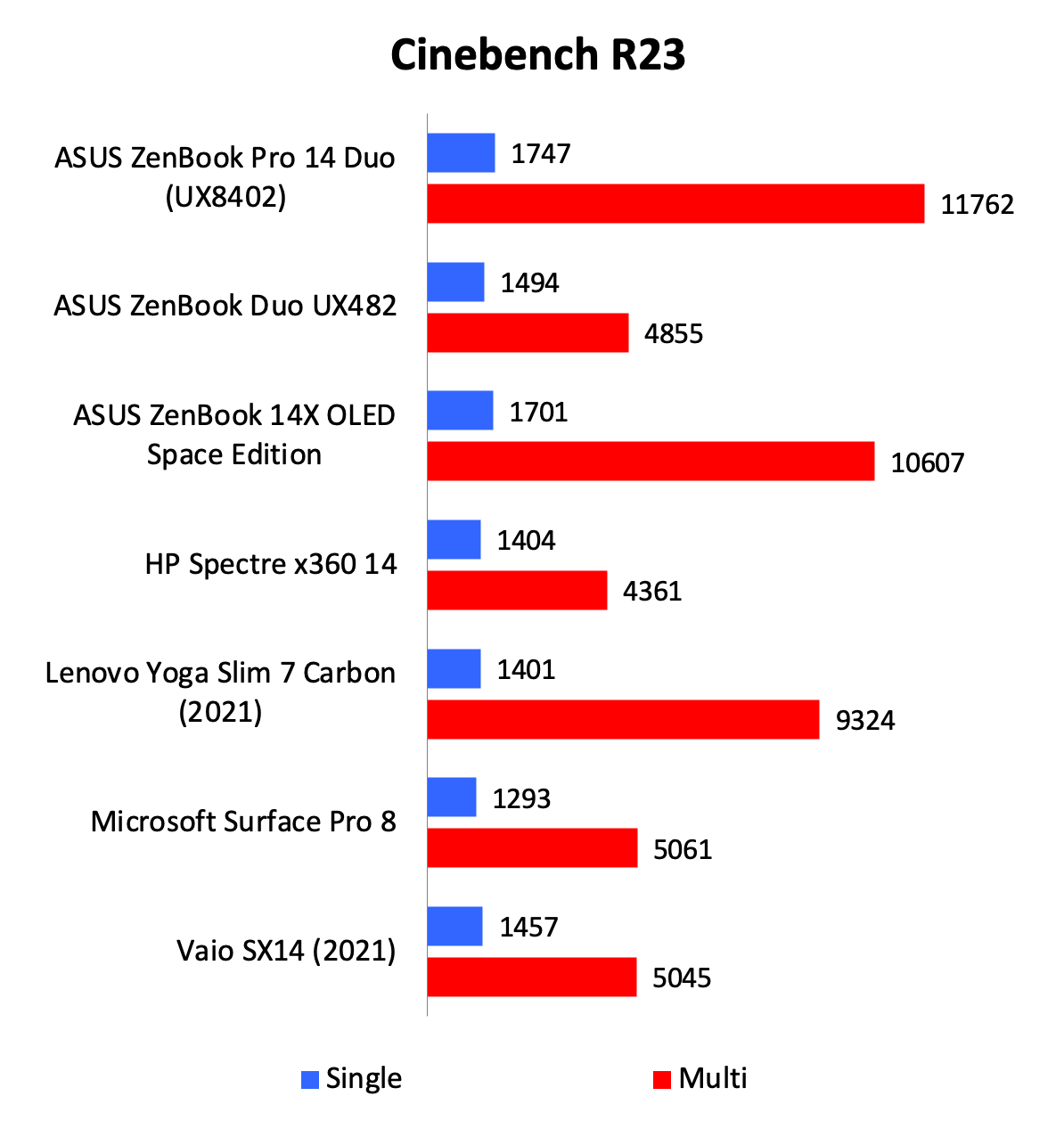

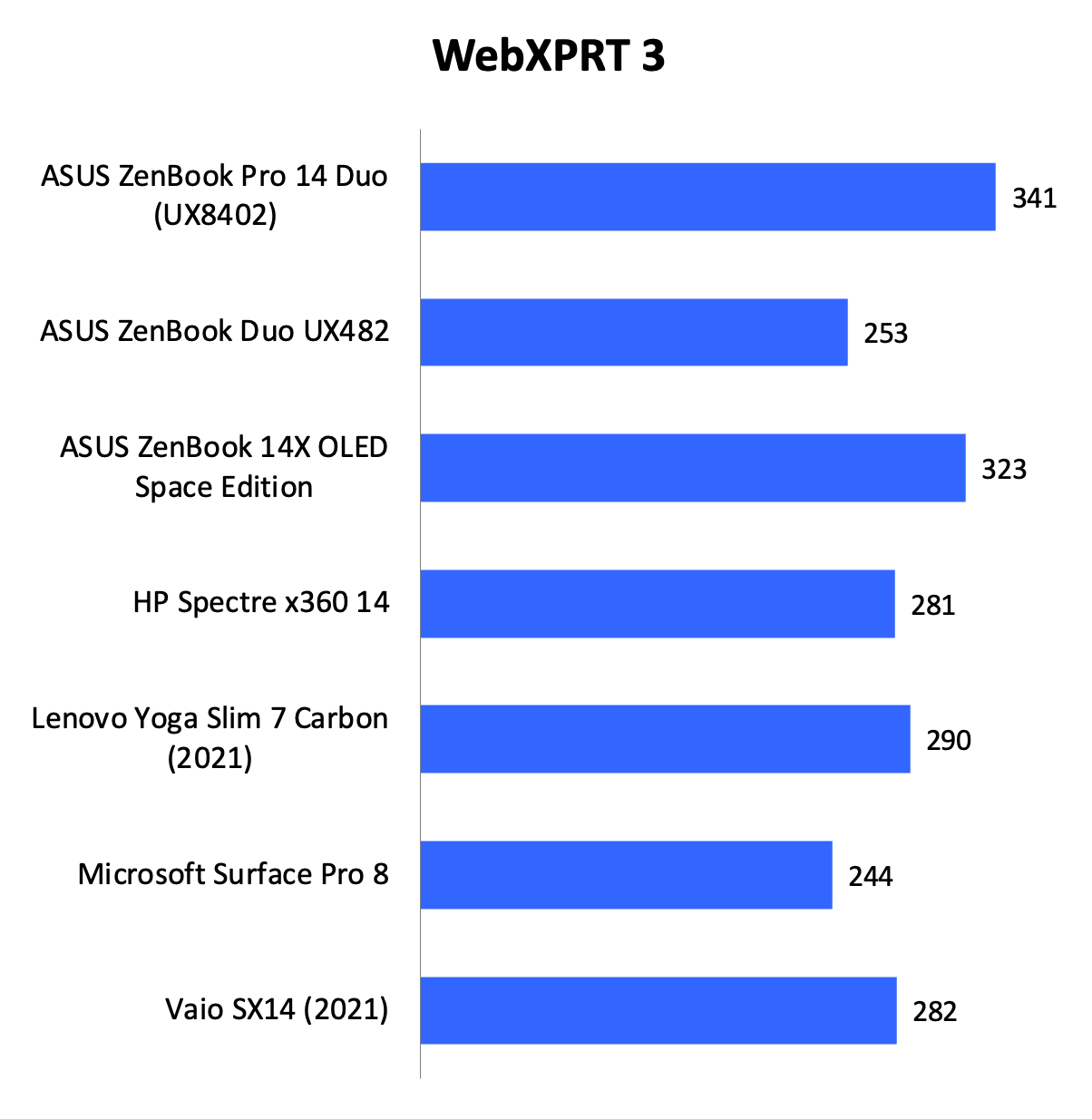
The GeForce RTX 3050 Ti GPU in the ZenBook Pro 14 Duo gave it scores on 3DMark that was unmatched by any other ultraportable. So to make things a little more fair, we decided to include proper gaming notebooks in our gaming benchmarks.
Performance on both Shadow of Tomb Raider and Deus Ex was decent. Granted, the tests were done only at Full-HD resolution, but even at maximum graphics settings, the ZenBook Pro 14 Duo managed very playable frame rates. Note also how much faster it was compared to ultraportable notebooks that relied on integrated graphics.
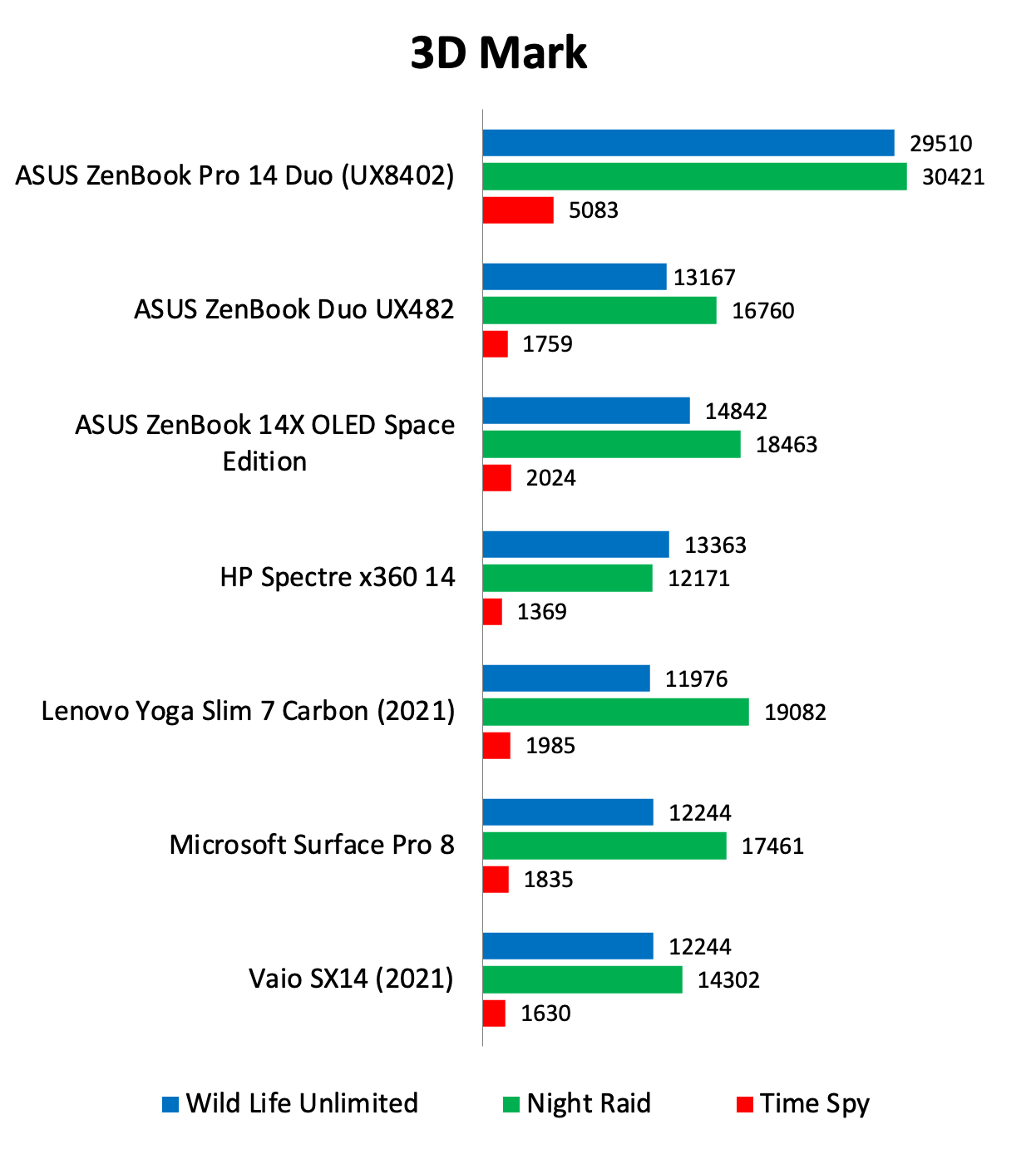
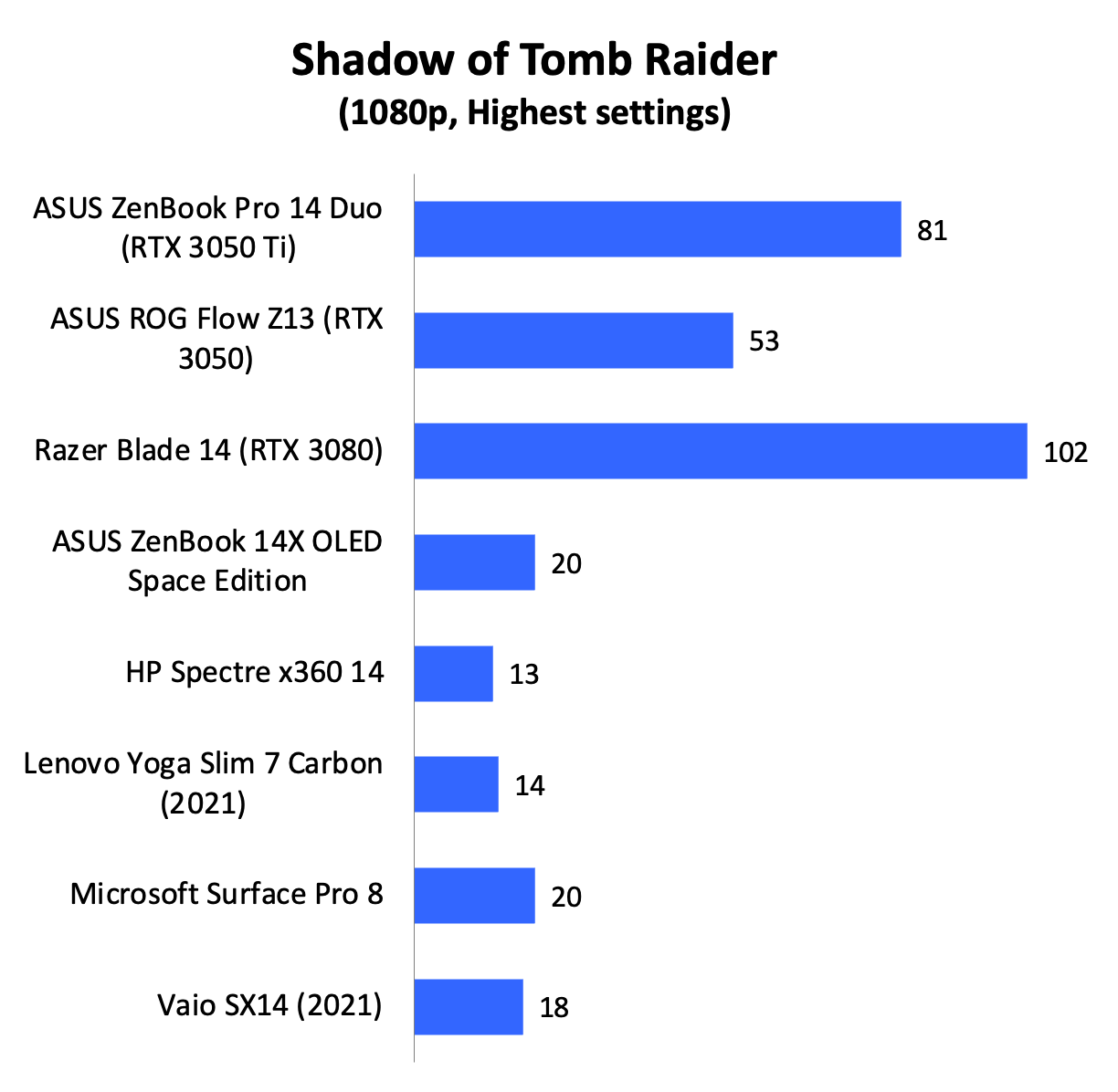
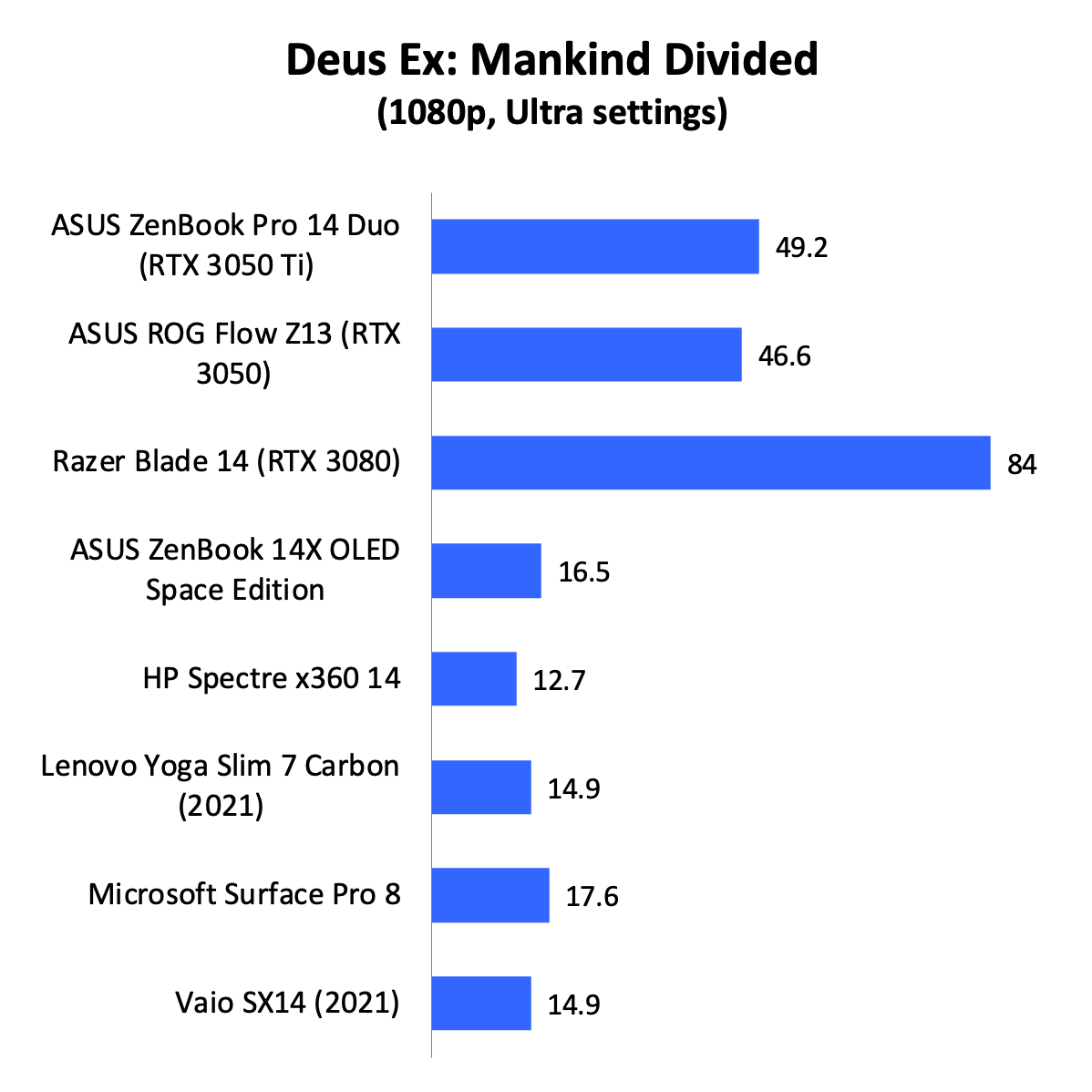

The ZenBook Pro 14 Duo has a performance mode which forces the fans to spin at their maximum speeds. This helped boost multi-core performance on Cinebench by around 15 per cent and Geekbench by a more modest 5 per cent. It also boosted 3DMark scores by around 18 per cent.
However, it had no effect on gaming frame rates. It seems performance gains are not consistent and depends highly on the app. Whether it’s worth using this mode is going to depend on your tolerance of fan noise because the fans get obnoxiously loud in this mode.
Note: Battery tests were conducted using PCMark 10's battery benchmark with display set to 100 per cent brightness.
Despite the larger battery, the new ZenBook Pro 14 Duo lasted over three hours less than its predecessor. That can be chalked down to the displays which have higher resolutions and refresh rates, and also the more powerful discrete graphics.
Still, a showing of over four hours is still pretty decent considering all that it offers. I also tested the notebook with the secondary display turned off and found that you can extend its battery life by an extra 1.5 hours.
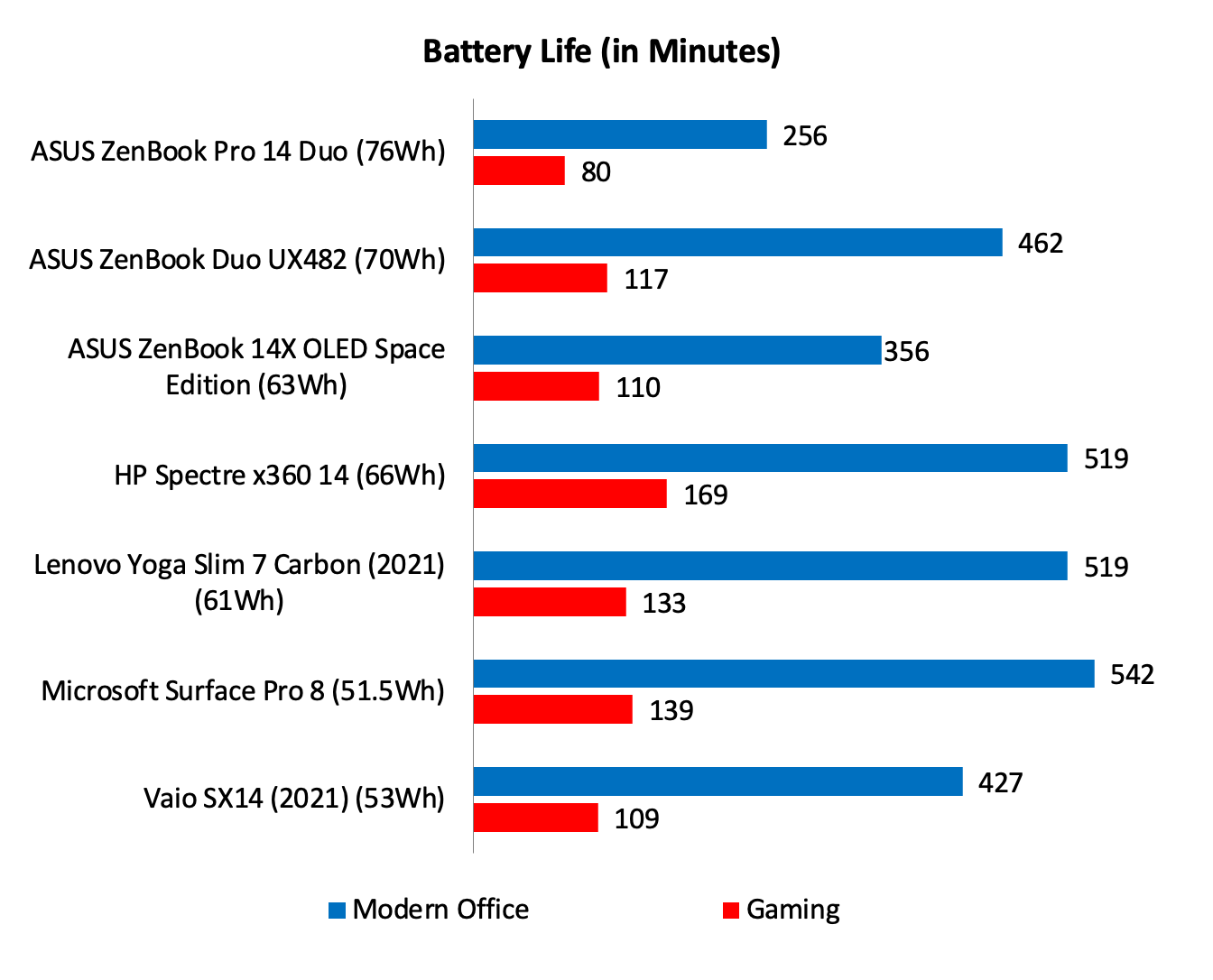


I want to start with a disclaimer. Since Asus hasn’t announced prices yet, it’s hard to give a conclusive verdict. So my assessment now is based solely on what the notebook offers and how it performs.
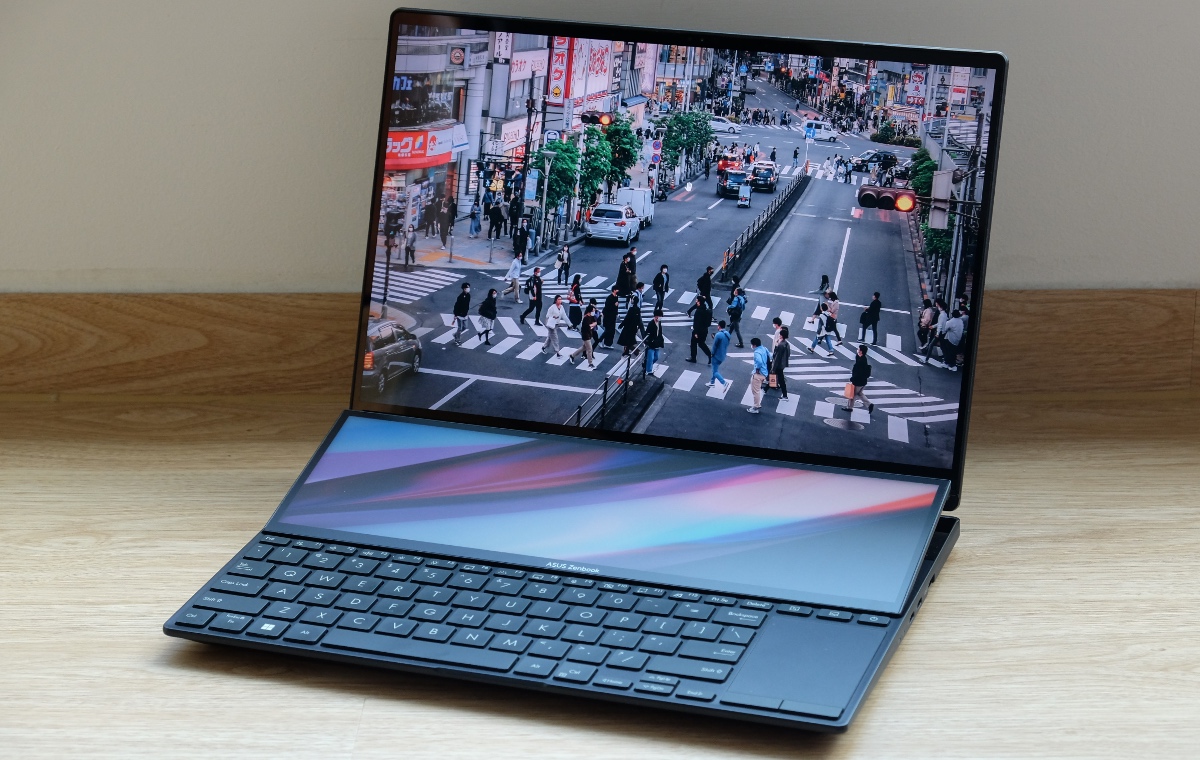
The new hinge and improved displays have had a profound impact on usability. The increased angle not only enhances the legibility of the secondary display but also makes it more coherent with the main display.
The two now flow into each other even more seamlessly, and at times, it’s almost possible to imagine that in front of you is a single large display.
Performance has also been improved substantially thanks to Intel’s new Alder Lake processor and discrete Nvidia GeForce RTX 3050 Ti graphics. This is now an even more capable machine for content creators. The inclusion of discrete graphics also means it can run most games decently as long as you dial back on the graphics settings.
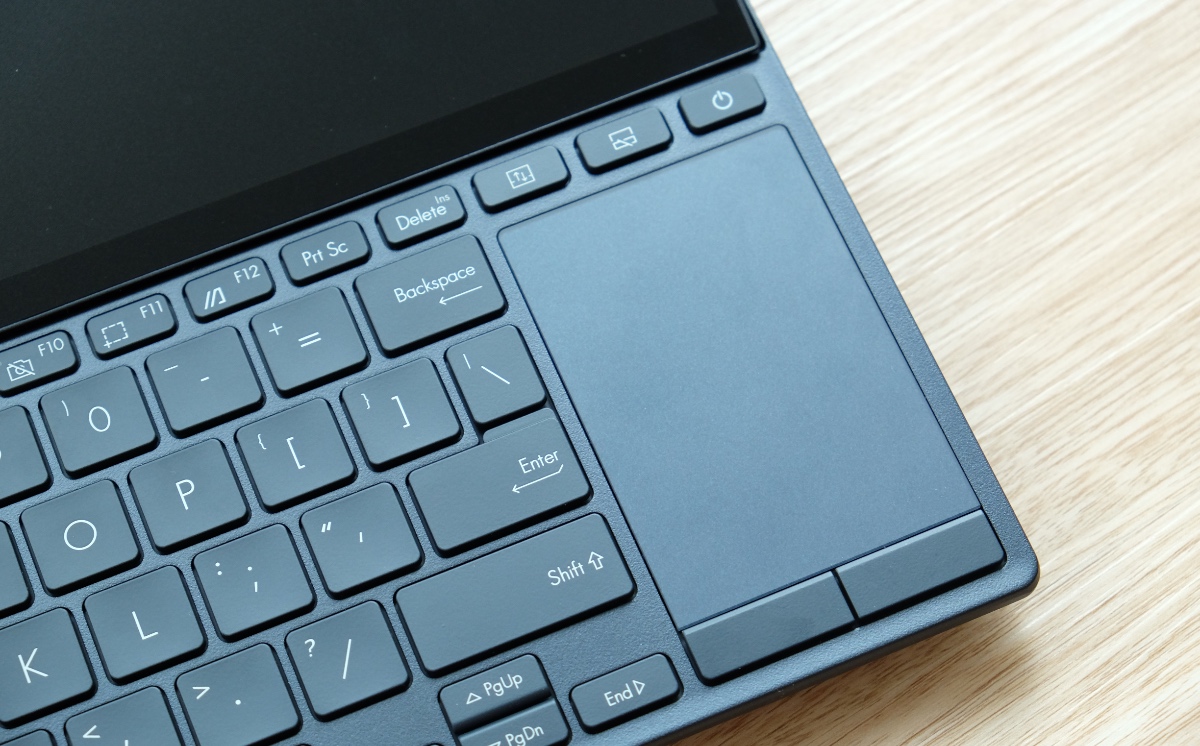
That said, some problems persist. The most conspicuous one being the keyboard and trackpad. The location of both is not ideal and will require considerable effort to get used to. Furthermore, the trackpad is small. If it’s any consolation, at least Asus nailed the feel of the keyboard.
The other issue with the ZenBook Pro 14 Duo is battery life. Despite the rather sizeable 76Wh battery, this notebook lasted significantly shorter than its predecessor – over 200 minutes less. Granted, much of this can be attributed to the higher-resolution, brighter displays and the presence of a discrete GPU, but that’s a considerable drop in battery life. Portability is not this notebook’s strongest suit.
ALSO READ: Review: ASUS ZenBook 14 Ultralight
In the end, despite the notable improvements, the ZenBook Pro 14 Duo still is a niche device that will likely appeal only to users who prioritise the dual displays over everything else. And if you are that kind of user, then you’ll find quite a lot to like about this notebook. As I said, the dual-display experience is better than ever and so is performance.
So has Asus perfected the portable dual-display notebook? Perhaps not quite. But is this their best yet? Oh yes, without question.
This article was first published in Hardware Zone.